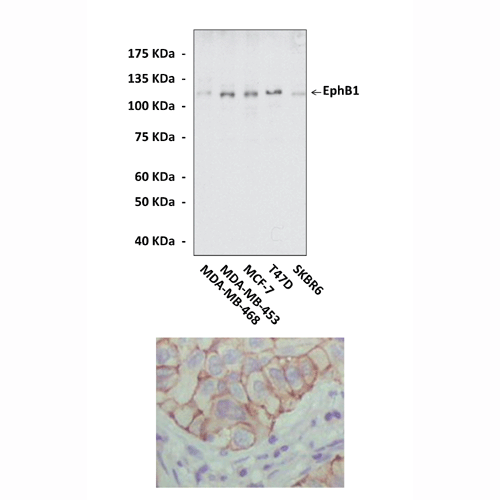Anti-EphB1: Mouse EphB1 Antibody |
 |
BACKGROUND Eph family of receptor tyrosine kinases consists of at least 14 distinct receptors and has eight membrane-bound ligands, known as the ephrins. This is the largest family of receptor tyrosine kinases. Eph proteins are divided into two subfamilies: the EphA receptors (A1-A8) that bind glycosyl phosphatidylinositol (GPI)-linked ephrin-A ligands (A1-A5), and the EphB receptors (B1-B6) that bind transmembrane ephrin-B ligands (B1-B3). The only known crosstalk between the A and B subfamilies occurs with the EphA4 receptor, which can bind ephrins-B2 and -B3 as well as the entire A subclass. There is a great deal of redundancy of receptor-ligand binding specificity within each subfamily, although binding affinities vary.1,2 Both GPI-anchoredephrinA and transmembrane ephrinB ligands interact with the Nterminal globular domain (Glob) of Eph receptors. The Eph receptors become phosphorylated at specific tyrosine residues in the cytoplasmic domain following ligand binding. Phosphorylated motifs serve as sites of interaction with certain cytoplasmic signaling proteins to mediate downstream signaling. In addition, through their C terminus the Eph receptors associate with PDZ (postsynaptic density protein, disc large, zona occludens) domain-containing proteins. Moreover, Eph receptor contact induces tyrosine phosphorylation of the cytoplasmic domain of ephrinB proteins via an SRC-family kinase (SFK), which mediating the reverse signaling. One of the unique features of Eph/ephrin signaling is the fact that both receptors and ligands are competent to transduce a signaling cascade upon interaction. Eph-activated signaling is termed forward, and ephrin-activated signaling is termed reverse. Another level of complexity stems from the fact that interactions between Eph receptors and ephrins can happen in trans (between two opposing cells) or in cis (within the same cell). It is commonly assumed that trans interactions are activating while cis interactions are inhibiting.3 Eph-Ephrin signaling functions in a variety biological processes including diverse assegmentation of the somites and rhombomeres, the formation of blood vessels, Axon guidance and fasciculation, migration of the neural crest and metastasis of transformed cells etc.
EphB1 is a member of the Eph family of receptor tyrosine kinases that play important roles in diverse biological processes including nervous system development, angiogenesis, and neural synapsis formation and maturation. EphB1 is found exclusively in regions of retina that give rise to the ipsilateral projection. EphB1 null mice exhibit a dramatically reduced ipsilateral projection, suggesting that this receptor contributes to the formation of the ipsilateral retinal projection, most likely through its repulsive interaction with ephrin-B2.4 EphB1 null mice exhibit neuronal loss in substantia nigra pars reticulata and spontaneous locomotor hyperactivity. Moreover, it was shown that dopamine activity regulates developmental expression of the tyrosine kinase receptor EphB1. It was demonstrated that that ligand-activated EphB1 forms a signaling complex with c-Src kinase and p52Shc, Grb7 adaptor proteins to promote extracellular signal–regulated kinase (ERK) 1/2 activation and cell migration. Moreover, the Ste20 kinase NIK couples EphB1 to JNK and integrin activation. In addition, it was shown that EphB1 could discriminate ephrinB1 surface density to direct integrin-mediated cell adhesion through “inside-out” signaling. On the other hand, Cbl binds to EphB1 through its tyrosine kinase-binding domain and induces the ubiquitination and lysosomal degradation of activated EphB1, a process requiring EphB1 and Src kinase activity. In addition, EphB1 is involved in the development, progress and prognosis of colorectal cancers.5
EphB1 is a member of the Eph family of receptor tyrosine kinases that play important roles in diverse biological processes including nervous system development, angiogenesis, and neural synapsis formation and maturation. EphB1 is found exclusively in regions of retina that give rise to the ipsilateral projection. EphB1 null mice exhibit a dramatically reduced ipsilateral projection, suggesting that this receptor contributes to the formation of the ipsilateral retinal projection, most likely through its repulsive interaction with ephrin-B2.4 EphB1 null mice exhibit neuronal loss in substantia nigra pars reticulata and spontaneous locomotor hyperactivity. Moreover, it was shown that dopamine activity regulates developmental expression of the tyrosine kinase receptor EphB1. It was demonstrated that that ligand-activated EphB1 forms a signaling complex with c-Src kinase and p52Shc, Grb7 adaptor proteins to promote extracellular signal–regulated kinase (ERK) 1/2 activation and cell migration. Moreover, the Ste20 kinase NIK couples EphB1 to JNK and integrin activation. In addition, it was shown that EphB1 could discriminate ephrinB1 surface density to direct integrin-mediated cell adhesion through “inside-out” signaling. On the other hand, Cbl binds to EphB1 through its tyrosine kinase-binding domain and induces the ubiquitination and lysosomal degradation of activated EphB1, a process requiring EphB1 and Src kinase activity. In addition, EphB1 is involved in the development, progress and prognosis of colorectal cancers.5
REFERENCES
1. Brantley-Sieders, D.M. & Chen, J.: Angiogenesis. 7:17, 2004
2. Murai, K.K. & Pasquale, E.B.: J. Cell Sci. 116:2823, 2003
3. Arvanitis, D. & Davy, A.: Genes & Dev. 22:416, 2008
4. Williams, S.E. et al: Neuron 39:919-35, 2003
5. Sheng, Z. et al: Pathobiol. 75:274-280, 2008
2. Murai, K.K. & Pasquale, E.B.: J. Cell Sci. 116:2823, 2003
3. Arvanitis, D. & Davy, A.: Genes & Dev. 22:416, 2008
4. Williams, S.E. et al: Neuron 39:919-35, 2003
5. Sheng, Z. et al: Pathobiol. 75:274-280, 2008
Products are for research use only. They are not intended for human, animal, or diagnostic applications.
Параметры
Cat.No.: | CP10305 |
Antigen: | Raised against recombinant human EphB1 fragments expressed in E. coli. |
Isotype: | Mouse IgG1 |
Species & predicted species cross- reactivity ( ): | Human, Mouse, Rat |
Applications & Suggested starting dilutions:* | WB 1:1000 IP n/d IHC 1:50 - 1:200 ICC n/d FACS n/d |
Predicted Molecular Weight of protein: | 110 kDa |
Specificity/Sensitivity: | Detects endogenous EphB1 proteins without cross-reactivity with other family members. |
Storage: | Store at -20°C, 4°C for frequent use. Avoid repeated freeze-thaw cycles. |
*Optimal working dilutions must be determined by end user.
Документы
Информация представлена исключительно в ознакомительных целях и ни при каких условиях не является публичной офертой








